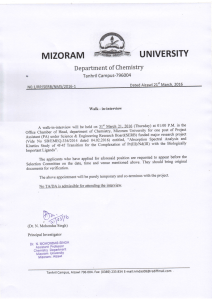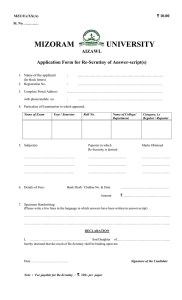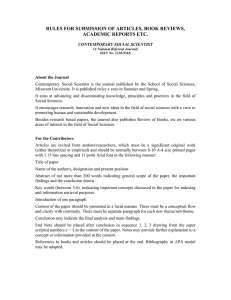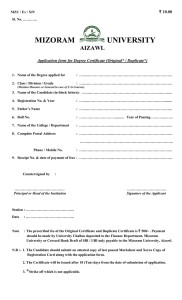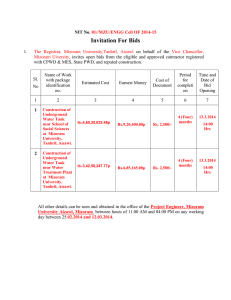Application of geo-spatial technologies for ground water quality
advertisement
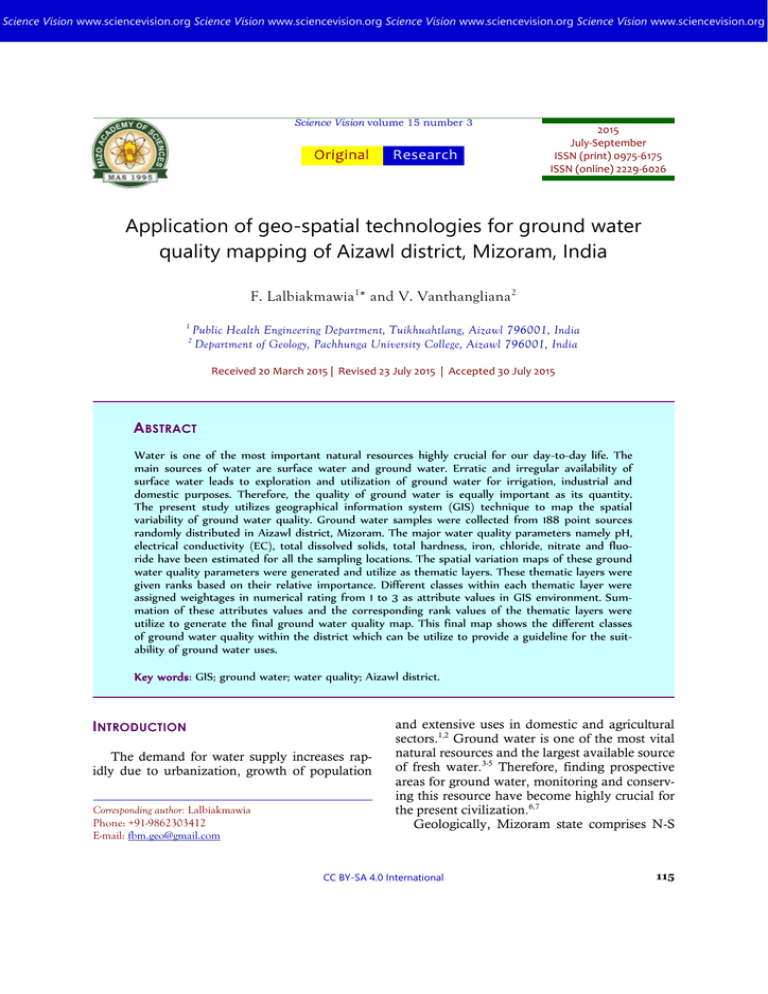
Science Vision www.sciencevision.org Science Vision www.sciencevision.org Science Vision www.sciencevision.org Science Vision www.sciencevision.org Science Vision volume 15 number 3 Original Research 2015 July-September ISSN (print) 0975-6175 ISSN (online) 2229-6026 Application of geo-spatial technologies for ground water quality mapping of Aizawl district, Mizoram, India F. Lalbiakmawia 1* and V. Vanthangliana 2 1 2 Public Health Engineering Department, Tuikhuahtlang, Aizawl 796001, India Department of Geology, Pachhunga University College, Aizawl 796001, India Received 20 March 2015 | Revised 23 July 2015 | Accepted 30 July 2015 ABSTRACT Water is one of the most important natural resources highly crucial for our day-to-day life. The main sources of water are surface water and ground water. Erratic and irregular availability of surface water leads to exploration and utilization of ground water for irrigation, industrial and domestic purposes. Therefore, the quality of ground water is equally important as its quantity. The present study utilizes geographical information system (GIS) technique to map the spatial variability of ground water quality. Ground water samples were collected from 188 point sources randomly distributed in Aizawl district, Mizoram. The major water quality parameters namely pH, electrical conductivity (EC), total dissolved solids, total hardness, iron, chloride, nitrate and fluoride have been estimated for all the sampling locations. The spatial variation maps of these ground water quality parameters were generated and utilize as thematic layers. These thematic layers were given ranks based on their relative importance. Different classes within each thematic layer were assigned weightages in numerical rating from 1 to 3 as attribute values in GIS environment. Summation of these attributes values and the corresponding rank values of the thematic layers were utilize to generate the final ground water quality map. This final map shows the different classes of ground water quality within the district which can be utilize to provide a guideline for the suitability of ground water uses. Key words: GIS; ground water; water quality; Aizawl district. INTRODUCTION The demand for water supply increases rapidly due to urbanization, growth of population Corresponding author: Lalbiakmawia Phone: +91-9862303412 E-mail: fbm.geo@gmail.com and extensive uses in domestic and agricultural sectors.1,2 Ground water is one of the most vital natural resources and the largest available source of fresh water.3-5 Therefore, finding prospective areas for ground water, monitoring and conserving this resource have become highly crucial for the present civilization.6,7 Geologically, Mizoram state comprises N-S CC BY-SA 4.0 International 115 Application of geo-spatial technologies for ground water quality mapping of Aizawl district, Mizoram, India trending ridges with high degree of slopes and narrow intervening synclinal valleys, faulting in many areas has produced steep fault scarps.8 Therefore, majority of the rain water available is lost as surface runoff even though the state received high amount of rainfall. Springs are the major sources of water in the area. Hence, the quality of water from such sources needs to be carefully analyzed and represented in a GIS environment.9 Few efforts were made to study water quality within the state of Mizoram. These include assessment of the water quality of Tlawng river in Aizawl, Mizoram;10 sulphate, phosphate-P and nitrate-N contents of Tlawng river, near Aizawl City, India;11 seasonal variation in water quality of Tuirial river in vicinity of the hydel project in Mizoram, India;12 physico-chemical characteristics of Tamdil in Mizoram, northeast India.13 Advent of geospatial technologies like utilization of geographical information system (GIS) and global positioning system (GPS) allows fast and cost effective survey and management for natural resources.14 Hence, this technique has wide-range applications including ground water quality mapping.15 Therefore, many researchers have utilized these techniques successfully in ground water studies, both for prospecting and quality mapping.16-21 The same techniques have been proved to be of immense value not only in the field of hydrogeology but also for the devel- Figure 1. Location map of study area. 116 Lalbiakmawia and Vanthangliana opment of surface water resources as well.22,23 MATERIALS AND METHODS Study area Location and extent Aizawl district is located in the northern part of Mizoram, in the north-east corner of India. Aizawl city, the state capital is situated within the district. With a total area of 3576.00 sq km the district is geographically located between 92 o 37′ 03"E to 93o 11′ 45" E longitudes and 23o 18′ 17"N to 24o 25′ 16" N latitudes. It falls under Survey of India topo sheet No. 83D/15, 83D/16, 84A/9, 84A/10, 84A/11, 84A/13, 84A/14, 84A/15, 84E/1, 84E/2, 83H/3 and 83H/4. Location map of the study area is shown in Figure 1. Climatic condition The climate of the study area ranges from moist tropical to moist sub-tropical. The entire district is under the direct influence of south west monsoon, with average annual rainfall of 2688.50 mm.24 Geology The earliest recorded work on geology of Mizoram was conducted in 1891 and it was reported that the area consisted of great flysch facies of rocks comprising monotonous sequences of shale and sandstone.25 The study area is underlain by Bhuban and Bokabil formations of Surma Group of Tertiary age which consist mainly of arenaceous and argillaceous type of rocks.8 Five litho-units have been established purely based on the exposed rock types of the area. These are named as sandstone unit, siltstoneshale unit, limestone unit, gravel, sand and silt unit and clayey sand unit. It was also observed that the rocks exposed within the study area were traversed by several faults and fractures of varying magnitude and length.26 Geomorphology The study area is characterized mainly by ridgelines and intervening valleys and less prominent ridges. Structural hills are the main geomorphic units which were divided as high, moderate and low structural hills based on their elevation. As the name implies, structural hills are of structural origin, associated with folding, faulting and other tectonic processes. Other geomorphic units like valley fill and flood plain are characterized by unconsolidated sediments, and were found along streams and major rivers respectively.27 Data used Base map of the study area was generated from thematic maps extracted from Natural Resources Atlas of Mizoram prepared by Mizoram Remote Sensing Application Centre (MIRSAC). Satellite data, SOI topographical maps and various ancillary data were also referred in the study. Records of ground water quality prepared by State Referral Institute (SRI), Aizawl were imported and plotted in a GIS environment. Software Prominent GIS softwares such as Quantum GIS and ArcInfo 10.1 version were used for analysis and mapping. Handheld GPS device was also utilized in the field for locating sample points and for ground verification. Data generation The base map was geo-referenced and digitized by using QGIS software and exported to ArcInfo 10.1 software for spatial analysis. The water samples were collected from one hundred and eighty eight locations and were tested for their physico-chemical parameters. The charac- 117 Application of geo-spatial technologies for ground water quality mapping of Aizawl district, Mizoram, India teristics of the water were subsequently evaluated using the Indian Drinking Water Standards as per BIS guideline. The major parameters namely pH, electrical conductivity (EC), total dissolved solids, total hardness, iron, chloride, nitrate and fluoride of the samples were analyzed. Spatial interpolation technique through inverse distance weighted (IDW) approach has been used in the present study for generating spatial distribution of the ground water quality. The spatial variation maps of major ground water quality parameters were prepared as thematic layers following BIS guideline. This guideline categorized each ground water parameters as desirable limit, permissible limit and nonpotable classes. The different classes within the BIS Guideline were represented in the present study as good, moderate and poor classes respectively. All the spatial variation maps/layers were integrated and the final ground water quality map of Aizawl district was then generated. ters. Based on these spatial variation layers of major water quality parameters, an integrated ground water quality map of Aizawl district was prepared using GIS technique. Results and discussion for the major parameters are as follows: Data analysis pH: pH is one of the important parameters of water which determines the acidic and alkaline nature of water. The pH value of water ranged between 6 and 9. The pH values of the samples were classified into two classes. As per BIS guideline, almost the entire area falls within desirable limit (6.5-8.5). Few locations were below 6.5 and above 8.5. Area with desirable limit were categorized as good class while those areas with pH value less than 6.5 or more than 8.5 were categorized as poor class. The spatial variation map for pH was prepared and presented in Figure 2. All the thematic layers were assigned different ranks based on their role in controlling the quality of ground water. All the layers were individually divided into appropriate classes and weightage value is assigned for each class based on their influence on the quality of ground water. This process is done in such a manner that less weightage represents better influence whereas and more weightage represent poorer influence towards the ground water quality. The assignment of weightage values for the different categories within a parameter is done in accordance to their assumed or expected importance in inducing different classes of the ground water quality.14, 20 RESULTS AND DISCUSSION The spatial and the attribute database generated are integrated for the generation of spatial variation layers of major water quality parame- 118 Table 1. Rankings and weightages of parameters. Parameter Ranking pH 15 Electrical conductivity (µmhos/cm) 15 Total Dissolved Solids (mg/l) 10 Total Hardness (mg/l) 10 Iron (mg/l) 10 Chlorides (mg/l) 10 Nitrate (mg/l) 10 Fluoride (mg/l) 10 Range <6.5 7.5 to 8.5 >8.5 0-2250 250-3000 0-500 500-2000 0-300 300-600 <0.3 0.3-1.0 <1.0 <250 250-1000 <45 45-100 <1.0 1.0-1.5 Weight 3 1 3 1 2 1 2 1 2 1 2 3 1 2 1 2 1 2 Electrical Conductivity (EC): The electrical conductivity (EC) of water was classified in to three ranges (0-2250 µmhos/cm, 2250-3000 µmhos/ cm and >3000 µmhos/cm) by BIS guideline. However, the study area has only two classes. Those areas having EC values between 0-2250 µmhos/cm were categorized as good class and those which are having the values ranging between 2250-3000 µmhos/cm were categorized as moderate class. The poor class (>3000 µmhos/ Lalbiakmawia and Vanthangliana 2: Spatial variation of .pH FigureFigure 2. Spatial variation mapmap of pH Figure 4. Spatial variation map of TDS. Figure variation map of Electrical Figure3:3.Spatial Spatial variation map of EC. Conductivity Figure 5: Spatialvariation variation map Total Hardness Figure 4. Spatial mapofof total hardness. 119 Application of geo-spatial technologies for ground water quality mapping of Aizawl district, Mizoram, India Figure 6. Spatial variation map of iron. Figure 7. Spatial variation map of chlorides. Figure 8. Spatial variation map Figure 8: Spatial variation mapofofnitrate Nitrate. Figure 9. Spatial variation map Figure 9: Spatial variation mapofoffluoride. Fluoride 120 Lalbiakmawia and Vanthangliana cm) was absent for the present study area. The spatial variation map for EC were prepared and presented in Figure 3. Total Dissolved Solids (TDS): The total dissolved solids (TDS) of water is classified in to three ranges (0-500 mg/l, 500-2000 mg/l and >2000 mg/l) by BIS guideline. However, the present study area has only the first two categories which are named as good class and moderate class respectively. The spatial variation map for TDS was prepared based on these ranges and presented in Figure 4. Total Hardness: The total hardness is classified in to three ranges (0-300 mg/l, 300-600 mg/l and >600 mg/l) by BIS guideline. The present study area has the first two categories only. These are categorized as good class and moderate class. Based on these ranges the spatial variation map for total hardness has been obtained and presented in Figure 5. two categories only which are termed good and moderate classes. The spatial variation map for fluoride has been presented in Figure 9. The final map shows the broad idea about good, moderate and poor ground water quality zones in the study area. The ground water quality has been classified quantitatively as good (47.79%), moderate (47.56%) and poor (4.66%) depending on the final weight values assigned to polygons in the final layer. Area coverage of ground water quality is shown in Table 2 and the ground water quality map is shown in Figure 10. Table 2. Area coverage of ground water quality. Ground Water Quality Class Area (Sq Km) Percent Good 1708.96 47.79 Moderate 1700.57 47.56 Poor 166.47 4.66 TOTAL 3576.00 100.00 Iron: Iron was classified in to three ranges (<0.3 mg/l, 0.3-1.0 mg/l and >1.0 mg/l) by BIS guideline. Based on these ranges, the study area is divided into good, moderate and poor classes. The spatial variation map for chlorides is presented in Figure 6. Chlorides: The chlorides was classified in to three ranges (0-250 mg/l, 250-1000 mg/l and >1000 mg/l) by BIS guideline. The study area has the first two categories only which are termed good and moderate classes. The spatial variation map for chlorides has been presented in Figure 7. Nitrate: Nitrate was classified in to three ranges (<45 mg/l, 45-100 mg/l and >100 mg/l) by BIS guideline. The study area has good and moderate classes only. The spatial variation map for nitrate is presented in Figure 8. Fluoride: Fluoride was classified in to three ranges (<1.0 mg/l, 1.0-1.5 mg/l and >1.5 mg/l) by BIS guideline. The study area has the first Figure 10. Ground water quality map. From the map, it is evident that the ground water quality in the northern and 121 Application of geo-spatial technologies for ground water quality mapping of Aizawl district, Mizoram, India south-eastern parts of the study area is in the good condition while the central part of the study area is in the moderate condition. There are few areas within Aizawl city and some areas within the district where the ground water quality is in poor condition. CONCLUSION The ground water quality map helps us to comprehend the existing ground water condition of the study area. The present study indicated that groundwater qualities in some urban areas are poor as per BSI guidelines. The integrated map shows the broad idea about good, moderate and poor ground water quality zones in the study area. The prediction of ground water quality zones can be used for ground water exploration, development and management programme. GIS technique has been proven to be useful tools for mapping ground water quality. The ground water quality map prepared through this study will be useful for planning future ground water developmental programme. ACKNOWLEDGEMENTS The authors are thankful to R. Lalruatkima, Hydrogeologist, PHE Department, Mizoram, for his co-operation and support during the study. REFERENCES 1. Choudhary BS, Kumar M, Roy AK & Ruhal DS (1996). Application of remote sensing and geographic information systems in ground water investigations in Sohna block, Gurgaon district, Haryana (India). Int Arch Photogramm Remote Sens, 31, 21. 2. Majumder A & Sivarama Krishnan L (2014). Ground water budgeting in alluvial Damodar fan delta: A study in semi–critical Pandua block of West Bengal, India. Int J Geol Earth Environ Sci, 4, 23–37. 3. Sharma MP & Kujur A (2012). Application of Remote Sensing and GIS for ground water recharge zone in and around Gola Block, Ramgargh district, Jharkhand, India. Int J Sci Res Pub, 2, 1. 122 4. Neelakantan R & Yuvaraj S (2012). Evaluation of ground water using geospatial data – A case study from Salem taluk, Tamil Nadu, India. Int J Remote Sens Geosci, 1, 7. 5. Kumar CP (2013). Assessment and strategies for development potential of deeper confined aquifers in India. Asian Acad Res J Multi, 1, 1. 6. Rokade VM, Kundal P & Joshi AK (2004). Water resources Development Action plan for Sasti Watershed, Chadrapur District, Maharashtra using remote sensing and Geographic Information System. J Indian Soc Remote Sens, 32, 359–368. 7. Kumar B & Kumar U (2011). Ground water recharges zonation mapping and modeling using Geomatics techniques. Int J Environ Sci, 1, 1671. 8. GSI (2011). Geology and Mineral resources of Manipur, Mizoram, Nagaland and Tripura. GSI, Misc Pub, No. 30 Part IV, 1, 36–39. 9. CGWB (2007). Central Ground Water Board, Ministry of Water Resources, Manual on artificial recharges for ground water. pp. 13. 10. Lalchhingpuii, Lalramnghinglova H & Mishra BP (2011). Assessment of the water quality of Tlawng river in Aizawl, Mizoram. Sci Vis, 11, 72–76. 11. Lalchhingpuii, Lalramnghinglova H & Mishra BP (2011). Sulphate, phosphate-P and nitrate-N contents of Tlawng river, near Aizawl City, India. Sci Vis, 11, 198–202. 12. Lalparmawii S & Mishra BP (2012). Seasonal variation in water quality of Tuirial River in vicinity of the hydel project in Mizoram, India. Sci Vis, 12, 159–163. 13. Mishra BP & Chenkual L (2014). Physico-chemical characteristics of Tamdil in Mizoram, northeast India. Sci Vis 14, 200–206. 14. Ganesh Babu O & Sashikkumar MC (2013). Application of GIS for ground water quality mapping of Tiruppur block, Tamil Nadu. Int J Remote Sens Geosci, 2, 18–25. 15. Ramakrishna, Nagaraju D, Lone MS, Siddalingamurthy S & Sumithra S (2013). Ground water prospectus studies of Tattekere watershed, Mysore district, Karnataka, India using Remote Sensing and GIS. Int J Remote Sens Geosci, 3, 6–10. 16. Gustafsson P (1993). High resolution satellite data and GIS as a tool for assessment of ground water potential of semi-arid area. IXth Thematic Conference on Geologic Remote Sensing. 8–11 February, 1993, Pasadena, California, USA. 17. Saraf AK & Jain SK (1994). Integrated use of remote sensing and GIS methods for ground water exploration in parts of Lalitpur District, U.P. India: International Conference on Hydrology and Water Resources. 20–22 December, 1993 at New Delhi, India. 18. Krishnamurthy J & Srinivas G (1995). Role of geological and geomorphological factors in ground water explora- Lalbiakmawia and Vanthangliana tion: A study using IRS–LISS–II data. Int J Remote Sens, 16, 2595–2618. 19. Krishnamurthy J, Mani A, Jayaraman V & Manivel M (2000). Ground water resources development in hard rock terrain – an approach using remote sensing and GIS techniques. Int J Appl Earth Obs Geoinf, 2, 204–215. 20. Karthikeyan N, Saranya A, & Sashikkumar MC (2013). Spatial analysis of ground water quality for Virudhunagar district, Tamil Nadu using GIS. Int J Remote Sens Geosci, 2, 23–30. 21. Dey S (2014). Delineation of ground water prospect zones using remote sensing, GIS Techniques – A case study of Baghmundi development block of Puruliya District,West Bengal. Int J Geol Earth Environ Sci, 4, 62–72. 22. Saraf AK & Choudhury PR (1998). Integrated remote sensing and GIS for ground water exploration and identification of artificial recharge site. Int J Remote Sens, 19, 825– 1841. 23. Sharma MP & Kujur A (2012). Application of Remote Sensing and GIS for ground water recharge zone in and around Gola block, Ramgarh district, Jharkhand, India. Int J Sci Res Pub, 2, 1–6. 24. Lalzarliana C (2013). Rainfall record of Mizoram. Directorate of Agriculture, Government of Mizoram, pp. 1. 25. La Touche THD (1891). Record of GSI, Geological Survey of India, 24(2). 26. MIRSAC (2006). Natural Resources Mapping of Aizawl district, Mizoram using Remote Sensing and GIS, A Project REPORT. Mizoram State Remote Sensing Centre, S&T, Planning Dept. Mizoram, pp. 28. 27. Lallianthanga RK & Lalbiakmawia F (2013). Landslide hazard zonation of Aizawl district, Mizoram, India using Remote Sensing and GIS techniques. Int J Remote Sens Geosci, 2, 14–22. 123
